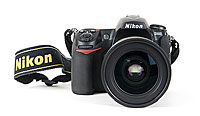
The Nikon D300 is a 12.3 megapixel high-end digital SLR designed to meet the needs of the advanced amateur and professional photographer. Nikon has positioned the D300 as both the class-leading DX body and a smaller companion body to the new D3 full-frame digital SLR. In the tradition of the F-series film camera bodies that made Nikon a household name, the D300 offers all of the features of a professional body at a fantastic price.
Want to buy a Nikon D300?
Compare prices and shop for a Nikon D300 digital SLR >>
| Nikon D300 Studio Test Images | ||
| ISO 100 Sample >> ISO 200 Sample >> ISO 400 Sample >> ISO 800 Sample >> ISO 1600 Sample >> ISO 3200 Sample >> ISO 6400 Sample >> |
||
Introduction
In late August 2007, Nikon made a set of groundbreaking announcements. The D3 had been highly anticipated and the subject of rumors for some time. What most did not expect was an update to the D200, much less a full replacement. At first glance the D300 may seem like an incremental upgrade to the D200. But it’s actually completely different beast, just as the D200 was to the D100. The D200 was designed as a semi-professional camera, ideal for pros who needed to travel light, as well as advanced amateurs. Nikon must have realized that with the introduction of the D3, there would be a need for a DX-format camera body that could fill these roles. That camera is the D300.
I’m a longtime Nikon fan, as well as a college newspaper photojournalist. I bought the D300 to replace my D200 and use on the job as a complement to my Nikon D3.
Features
Nikon’s new flagship DX crop camera, the D300, has it all – or almost all. There are only three significant features the D3 has that the D300 doesn’t: a virtual horizon feature; 9 to 11 FPS 14-bit raw shooting (versus the D300′s 2.5); and selectable crop modes. I doubt most D300 users will miss these.
The D300′s 12.3-megapixel CMOS sensor provides industry-leading resolution for the 1.5x digital crop format and a 14-bit analog-digital conversion. The 4288 x 2848 pixel files can be printed at 16-inches with no software resizing necessary. Much, much larger prints are possible with proper setup. Recording formats include three sizes of JPEG (3.1 to 12 megapixels), NEF RAW and TIFF, as well as options for compressed, lossless compressed and uncompressed.
The D3 and D300 both incorporate Nikon’s new EXPEED Image Processing Concept, using Capture NX algorithms coded for the lower power processor in the body. An upgraded, on-the-fly version of Nikon’s in-camera image processing, Active D-Lighting, offers three levels of dynamic range optimization. Active D-Lighting works in two ways: as a custom-tone curve that dynamically boosts shadow detail and preserves highlight detail, or by actually adjusting the metered exposure to preserve highlights and apply a more aggressive curve. This can be a useful feature. I don’t always use it, but it has come in handy in many situations.
If there’s a true “killer app” in the D300, it’s got to be the new Multi-CAM 3500 DX auto focus system. I’m convinced there’s some sort of sorcery involved here, because I’m having a hard time believing that it’s technically possible for an auto focus system to be this good. The D300′s 51 auto focus points include 15 cross sensors. Unlike those in previous bodies like the D200, the line-type sensors are extremely accurate and even perform well with tele-converters. An intelligent auto-area auto focus system appears to recognize potential subjects like eyes in a portrait situation, or a face in a wider shot. The Dynamic-area AF mode is the most powerful, with the option to use 9, 21, or 51 auto focus points for tracking. A fourth Dynamic-area AF mode, “51points 3D-tracking”, uses color information from the 1,005 pixel 3D Color Matrix Metering II sensor to track a subject from a selected AF point. While it is not intended for use in every situation, it is remarkably effective.
The D300′s LCD is a joy to use. The 922,000-dot full VGA LCD offers seven levels of brightness and an extraordinarily crisp display. In addition to displaying images, menus and Live View, the rear LCD will show the Shooting Info Display when the “info” button is pressed.

No high-end DSLR today would be complete without Live View. But as usual, Nikon has put its own spin on the idea. Live View on the D300 is accessed from the Release mode dial, so there is no ambiguity about whether it’s on or not. Composition gridlines and high levels of magnification for focus checking are available, which is especially effective on the large, detailed LCD. Nikon has implemented a two-pronged approach to auto focus in Live View: the standard method of flipping down the mirror to use conventional auto focus, and a contrast-detection auto focus in what is called “Tripod Mode” due to its slower speed. But handheld use of the latter is possible as long as your subject is reasonably static and you don’t move too much. The D300 also has an HDMI connector and Live View can be seen through a high def TV or computer monitor.
The D300 also features a self-cleaning sensor, which automatically operates on startup and shutdown, and can be run manually as well.
As Nikon’s top-of-the line DX-crop SLR, the D300 offers many features that professional photographers expect. The viewfinder is very large and bright for a non full-frame body, with 100 percent frame coverage. The D300 also has professional-level speed — with high frame rates, optional speed-boosting options and fast UDMA mode Compact Flash writing, the fastest method currently supported by a DSLR. The built-in pop-up flash might not seem like a pro feature. But it uses Nikon’s i-TTL flash metering and can be used to control remote wireless flash with Nikon Creative Lighting System-compatible flashes.
Nikon has further refined its menu system. The Playback, Setup, Shooting and Custom Settings menus all carry forward, while the Retouch menu from recent Nikon consumer DSLRs now makes an appearance. The former Recent Settings menu has now become a fully customizable “My Menu.” The Picture Control menu replaces the old Optimize Image menu. There are four relatively self-explanatory stock Picture Control presets – Standard, Neutral, Vivid and Monochrome – and each can be retroactively applied to files. They can also be customized with sliders for sharpness, contrast, brightness, saturation, and hue.
The Custom Settings menu has 48 settings with a few submenus, as well as more than 100 options divided into six categories. The new Retouch menu allows photo editing in all-JPEG output without ever leaving the camera. Editing original files will save the resulting image as a new file, preserving your original.
Camera Menus
 Nikon D300 Shooting Menu |
 Nikon D300 Playback w. Overview Data information |
|
 |
 |
|
| Nikon D300 Picture Control Menu (left) and adjustable sliders (right) | ||
 Nikon D300 Retouch Menu |
 Nikon D300 Custom Setting menu |
|
 Nikon D300 Customizable My Menu |
 Nikon D300 Shooting Info Display |
|
![]()
Design
 The D300 feels every bit as good as its spec sheet suggests. Its rubberized, contoured grip and magnesium-alloy body contribute to a solid, natural feel. Even the command dials are rubberized for optimal grip and quiet operation. They are also tilted slightly to better engage the fingers and enable more comfortable adjustments.
The D300 feels every bit as good as its spec sheet suggests. Its rubberized, contoured grip and magnesium-alloy body contribute to a solid, natural feel. Even the command dials are rubberized for optimal grip and quiet operation. They are also tilted slightly to better engage the fingers and enable more comfortable adjustments.
Ergonomic design is one of Nikon’s hallmarks. The D300 can be operated almost entirely by feel. Compared to the D200, the D300′s, the grip allows greater freedom of movement for the thumb to interact with the Main command dial and Multi-selector. Controls are placed logically and within easy reach. Commonly used controls have dedicated buttons and selectors on the camera body, with most set up so that you never need to take your finger off the shutter button.
The best part of the D300′s design, however, is customizability. Instead of allowing just one button to be customized, Nikon allows a host of features to be enabled for the AE/AF-L, FUNC and Depth of Field Preview buttons. The AF-On button on the grip can also be customized in a more limited fashion. Command dials can be enabled for playback and menu navigation. The center button on the multi-selector can be configured to zoom in to one of three preset magnifications or to zoom out to thumbnail or histogram view.
 |
 |
|
| Nikon D300 top & back controls | ||
 |
 |
|
| Nikon D300 Pop-up Flash & Release Mode Dial | ||
![]()
The D300 features a number of environmental seals designed to safeguard against dust and moisture. I have shot in the rain with the D300 without problems. However, this camera is not designed for serious wet weather operation. So if you’re planning to shoot in heavy rain, I’d advise using a cover of some sort, particularly over the pop-up flash.
Camera Experience
The D300′s complex Multi-CAM 3500 DX auto focus system is incredibly accurate and will do precisely what you want it to do, provided you have the patience to learn what makes it tick. The peripheral auto focus points have better accuracy than I have experienced on any film or digital SLR, including Nikon and Canon’s previous high-end cameras.
The D300 offers several auto focus modes. The 3D-tracking mode is a cool new concept for auto focus. Once auto focus tracking is initiated with the selected AF point, the sensor stores the subject’s colors and tracks it across the frame. It’s fun to watch as the focus point follows your subject around. It isn’t perfect, and isn’t for every situation, since you really need a distinct color to lock on, and areas with similar colors have fooled the camera in my experience. I usually use the 9 or 21-point Dynamic-area AF modes, or occasionally, when the subject fills more of the frame, I use the 51-point Dynamic-area AF. It is important to keep track of your subject size in relation to the frame, and use the proper Dynamic-area AF mode, or you could hurt your chances of proper tracking.
White balance performance is excellent in most situations. As expected, the D300 still hasn’t achieved perfection in incandescent (tungsten) light, but using a WB preset or Kelvin white balance easily combats that. The LCD is quite accurate when brightness is adjusted properly, and can be used for rough WB estimates. Live View mode allows you to preview and adjust your white balance settings on the fly without taking superfluous shots. There is also a new series of white balance presets for fluorescent light, including sodium and mercury vapor.
The Scene Recognition System, introduced in August of 2007, lives up to the hype. It identifies types of subjects and scenes and uses that information for better metering, white balance, and auto focus. Nikon has had a great system since the D200, and it only gets better in the D300 with improved metering accuracy and the industry’s best Auto ISO. Metering is consistent and reliable, though it seems to expose a bit hotter than some previous Nikon bodies. On the D300 in auto ISO mode, you can do two things you could not previously: set an upper limit in the high range (ISO 6400 maximum) and engage Auto ISO at any sensitivity. This is by far my most used feature. I have Auto ISO on more than 80% of the time, primarily in Aperture Priority and Manual exposure modes. It allows me the flexibility of simply choosing my shutter speed and aperture limits and letting the camera choose exposure settings anyway it sees fit.
The D300 shoots at six or eight frames per second, depending on the battery. However, in 14-bit RAW mode the frame rate drops to 2.5 frames-per-second. And with Auto ISO engaged, maximum shooting rate drops to 7.5 FPS. This is still very fast, and I have not really felt the speed difference between 7.5 and 8. I don’t shoot action in 14-bit RAW, for the file size goes up too much and 2.5 frames-per-second is unacceptably slow for that kind of shooting. Not being able to shoot sports in 14-bit RAW mode is the only real disappointment for me in terms of speed.
Battery life is a marked improvement over the D200. In my experience, the D300 gets nearly twice the number of shots per charge with the exact same EN-EL3E batteries. With an EN-EL4a battery in the optional MB-D10 battery pack and an EN-EL3 in the camera, it can keep going for well over a thousand photos.
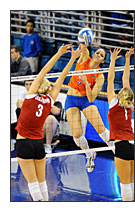 The D300 is one of the first cameras to support the UDMA CompactFlash read/write speed standard, which significantly improves buffer flush times. I now exclusively use Lexar Extreme IV and 300X cards in my D300. They write out very quickly, enabling me to keep a burst going long enough to cover just about any play in basketball, volleyball, lacrosse, tennis, baseball, softball, and football.
The D300 is one of the first cameras to support the UDMA CompactFlash read/write speed standard, which significantly improves buffer flush times. I now exclusively use Lexar Extreme IV and 300X cards in my D300. They write out very quickly, enabling me to keep a burst going long enough to cover just about any play in basketball, volleyball, lacrosse, tennis, baseball, softball, and football.
The D300 LCD is fairly bright, however in direct sunlight you may need to shade it some with your hand. Removing the included LCD protector can hurt in this situation, as the LCD seems brighter and more contrasty in without it. The screen itself is pretty durable, so I don’t worry too much about taking the protector off every now and then.
The very high resolution has increased sensitivity to camera shake that some photographers noticed with the D2x and D200. The D300 requires good handholding technique to avoid motion-induced blur.
Image Quality
The D300 really raises the bar for image quality from APS-C crop sensors. Low ISO performance is exemplary with a tremendous amount of detail captured in every 12-megapixel file. Appropriate sharpening must be applied to the files, as the default sharpening of “3″ on the 0-9 picture control scale is a bit weak for the D300′s anti-aliasing filter. I normally shoot at “5″ and use unsharp mask as necessary in post-processing. Colors are rendered with natural skin tones and accurate color reproduction overall. I tend to boost saturation and contrast one notch, which results in colorful, punchy files that require only a tiny bit of post-processing.
Nikon has finally caught up with and even beaten Canon at its own game of high ISO image quality. As has become the norm for Nikon bodies, in-camera noise reduction is available and kicks in at ISO 800. I have had numerous ISO 1600+ photos published in newsprint and online, and the results have been fantastic. While ISO 6400 (Hi-1.0) adds some luminance speckling to the image, this can be cleaned up without a lot of effort using Photoshop, Capture NX, or your favorite noise reduction software. I’ve had success cleaning up the speckling with standard Photoshop CS3 filters such as a very high threshold Dust and Scratches filter. I have an 8×10 color print from a photo I took with the D300 at ISO 6400 under sodium vapor lamps. The noise is all but invisible in the print, and there is a huge amount of detail- with no additional noise reduction beyond setting the “High ISO NR” option in the Shooting Menu to “Low.” However, I cannot stress enough the importance of proper exposure at high ISO. Above ISO 1600, if you mess up the exposure, you may encounter significantly more noise than you would have otherwise.
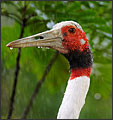 |
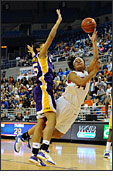 |
 |
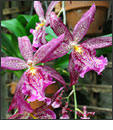 |
Click on thumbnails to view sample photos.
Conclusion
The D200 was designed to be a “baby” D2X. The D300 was designed to be a better D2X at a third of the cost. Nikon succeeded admirably in this design goal. The D300 delivers superb image quality along with worthwhile feature and functionality advancements. It also offers added versatility and some extremely compelling new features compared to the D200. Although priced higher than its closest competitors — Canon EOS-40D, Sony A700, Olympus E-3, and Pentax K20D — I believe the D300 is aimed a bit higher – in large part replacing the D2X as Nikon’s new pro DX-format body.
I hadn’t planned to buy a D300. But initial reports from camera trade shows got me interested enough to replace my D200 early. It was an excellent decision. The auto focus system alone was more than worth the jump. When combined with the MB-D10 grip, the D300 feels almost entirely as solid as the D3 and offers almost all the same features. But it can also be stripped down to a compact body in seconds.
Who Should Buy It
The D300 is for any serious photographer – the serious amateur, the occasional event shooter, and the full-blown professional. I’ve been all three of these, and I made a concerted effort during the past two months of testing to use it in situations that all three types of photographer would. In each case the D300 met or exceeded my every expectation, and surpassed every camera I’ve used shy of the D3.
The price point also makes it very accessible. Before upgrading to a D300, however, potential purchasers should evaluate the quality of their lenses, as the D300 shines when coupled with high-quality optics.
Photographers who may not need the D300′s huge feature set may wish to save a little money by purchasing a new or used D200. However, the D300 price will drop over time and cost will become less of an issue.
- end -
Contents of the Nikon D300 Box
|
Other Resources:
Nikon Review Page >>
Shop For Nikon D300 >>
Nikon D300 User Reviews >>
Write a Nikon D300 Review >>
Nikon D300 Camera Specs >>
Nikon D300 Sample Gallery >>
Nikon Web site >>
Nikon D300 Camera Manual >>
All Digital Camera Pro Reviews >>
Digital Camera Buyer’s Guide >>
All Digital Camera Sample Images >>
deckcadet Profile >>


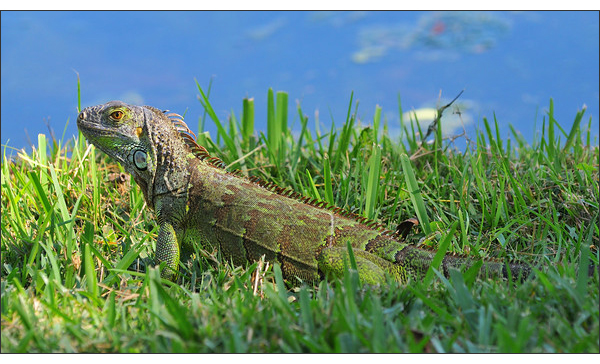


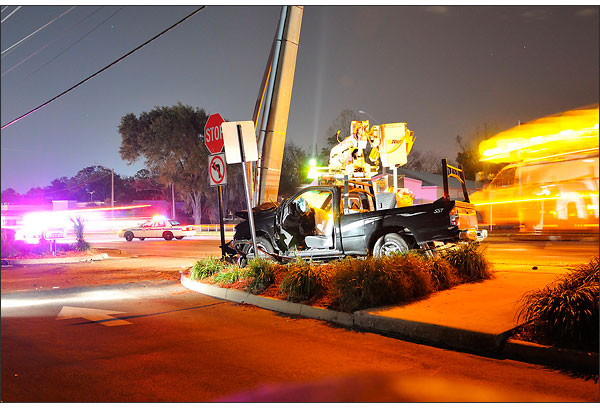
A very thorough and well written review. As a life long Nikon user I am very gratified to hear from one I trust that my next Nikon purchase will be well worth the wait and will meet the high standards that I have come to expect from Nikon.
Another excellent review. I just got the D300 and your reveiw enabled me to “hit the ground running” without the many hours I usually spend pouring over the rather prodigeous manual now packed with these new electronic devices. I owned a D100 and a D200. You are right; this is the best of the lot. I have owned Nikon SLR’s since they were first introduced. I am retired now so I don’t even think about the D3, on my income. The D300 will do quite well. Folks should take your reviews “to the bank”. You are right on target in every one I have seen. Keep up the good work.
Ralph-
I’m glad you liked Harrison’s D300 review and our Nikon D40x review. It’s nice to hear that people appreciate what we’re doing. We could use your D300 review in our user reviews. User reviews are the foundation of the site and since you’ve owned a bunch of Nikon DSLRs, your review would be extra valuable. I hope you’ll post a review:
Read and write Nikon D300 user reviews >>
Thanks again for your comments and thanks in advance for your reviews!
John Shafer
Photo-John
PhotographyREVIEW.com
Fantastic camera maybe, but it amazes me how digital technology is altering the face of photography.
The guy who states he loves his D300 after already buying a D200 & D100 tells it all.
Whats that, 3 brand new cameras after what, 5 years?
Whatever happened to the buy a camera, (which is very expensive) and keeping it for a good few years?
I bought my D200 in May 2006 to wild acclaim, I did not think for one minute it would’nt be superceded, however I am amazed it is basically obsolete after less than 2 years.
This is not a good way forward for our hobby.
I am in agreement with Warren. The DSLR world is all about upgrading! Read the reviews, photog enthusiasts go from the D100 to the 200 now to the 300, all in only a handful of years!! Just wait, Nikon will present the D400 by 2009!!! I’d bet on it! I had an Nikon F4s and used it professionally for over 10 years before going to the F5, which I used for nearly 8 years!! Both were fantastic. I now have the D200. For what I do, it is excellent!! Most of the comparison tests are absurd. The human eye simply cannot detect the differences that we are being lead to believe are there!! Not a knock on the 300, a great camera I am sure. But I am ordering a back-up to my D200 Monday at B&H, and it’s going to be another 200 at nearly 600 bucks less!!! A great camera for many years to come. Don’t get sucked into the hype!! Hey, it’s all about sales!!
Great review Photo John! But I have a question. You listed under “Cons” that the Multi-selector does not have a dedicated center button. Later in the review you point out that the button can be programmed to zoom to check focus of the image, which is a great thing to have, and was introduceded on the D200. What woould be the purpose of a dedicated button? Or why should this be a con? When I read the “Cons” at first I thought I was going to have to wait for the D400 to see if Nikon would bring back the center button.
Warren & Welan…time to join the 21st century.
I noted Welan’s comments earlier about the D300, and how he used his F4 for 10 years, etc.
Our film cameras were built to last decades because film technology flattened in the mid-1980s. Lenses made only the smallest of improvements, mostly in zooms. A 1964 Nikon F with a 105mm f2.5 lens didn’t get noticeably different images than an F4 with a similar lens three decades later.
The simple fact is, the core technology of digital cameras is constantly changing. Sensors and support electronics and processing technology is moving at an accelerating pace. The old standards of equipment life are dead and gone forever. My old NEC 286 computer was build to last 20-30 years of hard use. My D70 will be running strong in 2020, I am sure. But it will be as obsolescent as my NEC 286 by then.
As for saving $600 to buy a D200 versus a new D300, if you don’t make money shooting. that might make sense. But if you do, one single shot with a D300 just might pay for the difference. I don’t make images large enough in my work to justify a D3, but if I did, I’d be buying one in a heartbeat. That difference was never there between, say, a Minolta SRT-101 and a Nikon F, as W Eugene Smith proved. But it’s reality today in 2008.
Juan,
I am the author of the review, not Photo John. The multi selector still has the center-press function, but unlike the D3 which has a distinct button that can be pressed there, you have to do the old method (as seen on the D200 and D2 series) and push the whole thing in. Unfortunately if you don’t hit it correctly you can accidentally change images, display modes, or focus points. It’s much easier on the MB-D10 joystick to center-press consistently.
As far as the posts on the pace of the digital world go, Mel really hit the nail on the head- with film, the image quality was dependent on the lens and the film. The film could be changed at will. The body was simply there for other features- metering, autofocus, continuous shooting, flash, and the like.
Now the digital body contains the film.. and the film is getting better and better all the time. Just like computers, the processing power increases regularly, improvements in sensor technology come regularly and so on.
I believe, though, that the D300 offers a substantial improvement in the ‘body’ features that makes it a worthy upgrade for many D200 owners. The D100 was great in its time (2001 or 2002) but by the time the D70 came out it was obsolete due to advances in power and price improvements. The D200 made the D100 look like a joke of a semi-pro camera because Digital was in its earliest years with the D100.
The D200 isn’t a bad camera, and it takes just as good pictures as it did on December 15, 2005 when the first ones started shipping. But for a lot of people, the image quality improvements (which are there and noticeable, believe me), and more importantly the overall functionality improvements are enough to justify the extra cost.
Thanks for answering Juan’s question, Harrison (deckcadet). Your review is very popular!
Hay deckcadet,
Great review.
Ive been thinking about upgrading my D200 to a D300 to take advantage of the higher ISO setting capability in the D300. I mainly shoot indoor sporting events; equestrian.
At the higher ISO setting ( >1000) do you really notice a big difference in picture quality when comparing the D200 and D300?
Thanks
http://www.tobography.com
Scott,
Sorry to take so long to reply, but I hadn’t checked the comments in a bit.
Part of it will depend on your workflow, but I find when comparing properly exposed D300 and D200 files either shot JPEG in camera or NEF files processed in Nikon Capture NX there is a clear improvement of at least one full stop in terms of visible noise, and more than that in detail and color retention.
If you use other converters, your results may vary.
I am not sure what this reviewer is referring to when he says the center of the multiselector is not a “dedicated” button,
. But I must tell him; I have two D-300s and I set both so that I get a 100% view of my shots with one press of the center button.
If he wants choices I suggest he read pages pages 301-301 and finds out just what the center button can do.
You are misinterpreting what I’m saying, Nick. I’ve been using Nikon DSLRs for years and I’ve always set my center press to activate zoom in to 50% view (100% is not always representative). I am quite familiar with the center press options, and If you want to know a secret, I don’t enjoy being told to read the manual, though I understand you mean well :-). FWIW, I read the manual 4 times before I got the camera, thanks to the PDFs being posted early.
What I am saying is that the center PRESS is different than having a separate BUTTON like on the D3. Look at an image of the rear of the D3, and you’ll see what I mean. Rather than have to press in the whole multi selector, which can accidentally trigger a focus point move in 8 directions, or flip through info displays or images in review, or change the selected menu item, the D3 has an independent button at the center of the multi selector that does not require pushing in the entire assembly. It is a much better system and has been implemented in the D700.
Pingback: Nikon D700 Preview - Baby D3?
Awesome review Deckcadet! I just purchased a D300 (it’s my Christmas present) and it is reassuring to read your review and see that it is what I thought it would be. Now I also know some of the tweaks to apply as well.
While the D300 has several upgrades over the D200, the useable high ISO capability is really the item that sold me. I shoot weddings, and I do some contract work for a full time pro wedding photographer in town. Most churches are not well lit, and shooting a reception at the state Aquarium is enough to give a photographer nightmares.
I love my D200, and it is not going to be retired. I have shot roughly 30,000 frames with it, and the image quality is great. It will beome my backup camera when doing a paid shoot after the D300 gets here.
I have been looking for a camera that produces vibrant colors and very rich in color and also has a winning quality in shooting action shots in low light. I think this is probably one of the best! I am an avid Nikon user and currently im using a Nikon D60 and I think im going to upgrade on this one. What a great review!
mac
Nikon just announced the new Nikon D300s – basically a D300 with 720p HD video. It’s also the first DSLR with video to have auto focus available while recording video.
Nikon D300s Introduction >>
If you’re reading this review and you already own a Nikon D300, please write a review. Your user reviews are the foundation of PhotographyREVIEW.com. They are what make this site possible.
i would like to see the d 300 compared to a d90 i am going to buy one or the other next week. i am a newbe so even the simplest comparesion would help